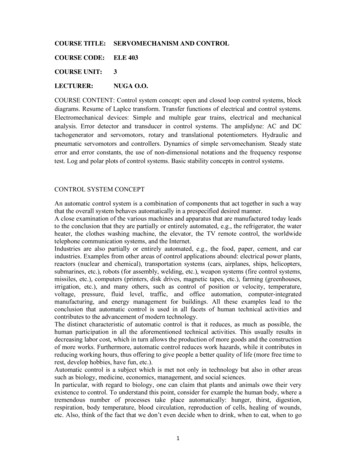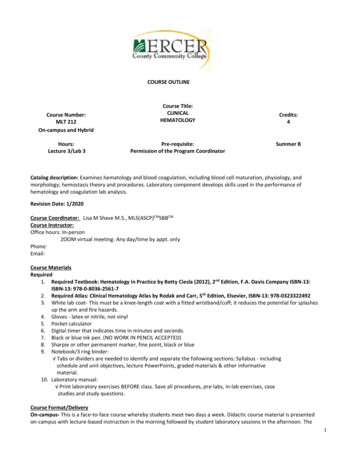
Transcription
U.S. ARMY MEDICAL DEPARTMENT CENTER AND SCHOOLFORT SAM HOUSTON, TEXAS 78234-6100INTEGUMENTARYSYSTEMSUBCOURSE MD0575EDITION 100
DEVELOPMENTThis subcourse is approved for resident and correspondence course instruction. Itreflects the current thought of the Academy of Health Sciences and conforms to printedDepartment of the Army doctrine as closely as currently possible. Development andprogress render such doctrine continuously subject to change.ADMINISTRATIONFor comments or questions regarding enrollment, student records, or shipments,contact the Nonresident Instruction Branch at DSN 471-5877, commercial (210) 2215877, toll-free 1-800-344-2380; fax: 210-221-4012 or DSN 471-4012, e-mailaccp@amedd.army.mil, or write to:COMMANDERAMEDDC&SATTN MCCS HSN2105 11TH STREET SUITE 4192FORT SAM HOUSTON TX 78234-5064Approved students whose enrollments remain in good standing may apply to theNonresident Instruction Branch for subsequent courses by telephone, letter, or e-mail.Be sure your social security number is on all correspondence sent to the Academy ofHealth Sciences.CLARIFICATION OF TRAINING LITERATURE TERMINOLOGYWhen used in this publication, words such as "he," "him," "his," and "men" are intendedto include both the masculine and feminine genders, unless specifically stated otherwiseor when obvious in context.
TABLE OF CONTENTSLessonParagraphsINTRODUCTION1ANATOMY AND PHYSIOLOGY OF THEINTEGUMENTARY SYSTEM1-1--1-1-5Exercises2PHYSICAL ASSESSMENT OF THE INTEGUMENTARYSYSTEM2-1--2-8Exercises3PRIMARY AND SECONDARY SKIN LESIONS3-1--3-5Exercises4COMMON SKIN DISEASES4-1--4-6Exercises5DERMATOLOGICAL DRUGS5-1--5-14ExercisesMD0572i
CORRESPONDENCE COURSE OFTHE ACADEMY OF HEALTH SCIENCES, UNITED STATES ARMYSUBCOURSE MD0575INTEGUMENTARY SYSTEMINTRODUCTIONThe skin is not just a simple thin covering which keeps the body together. The skin is a complexcombination of tissues that perform functions necessary for human survival. Our skin helps maintainbody temperature, receives stimuli from the environment, and stores chemical compounds. Consider thehuman predicament if the skin were not waterproof. Every time it rained, each human would absorbwater like a sponge. The skin also acts as a protective covering keeping underlying tissues from bacterialinvasion and harmful light rays and from drying out. As a Medical NCO, it is important for you tounderstand the complex functions of the skin.Subcourse Components:The subcourse instructional material consists of the following:Lesson 1, Anatomy and Physiology of the Integumentary System.Lesson 2, Physical Assessment of the Integumentary System.Lesson 3, Primary And Secondary Skin Lesions.Lesson 4, Common Skin Diseases.Lesson 5, Dermatological Drugs.Here are some suggestions that may be helpful to you in completing thissubcourse:--Read and study each lesson carefully.--Complete the subcourse lesson by lesson. After completing each lesson, workthe exercises at the end of the lesson, marking your answers in this booklet.--After completing each set of lesson exercises, compare your answers with thoseon the solution sheet that follows the exercises. If you have answered an exerciseincorrectly, check the reference cited after the answer on the solution sheet todetermine why your response was not the correct one.Credit Awarded:To receive credit hours, you must be officially enrolled and complete anexamination furnished by the Nonresident Instruction Branch at Fort Sam Houston,Texas. Upon successful completion of the examination for this subcourse, you will beawarded 8 credit hours.You can enroll by going to the web site http://atrrs.army.mil and enrolling under"Self Development" (School Code 555).MD0572ii
A listing of correspondence courses and subcourses available through theNonresident Instruction Section is found in Chapter 4 of DA Pamphlet 350-59, ArmyCorrespondence Course Program Catalog. The DA PAM is available at the followingwebsite: 572iii
LESSON ASSIGNMENTLESSON 1Anatomy and Physiology of the Integumentary System.LESSON ASSIGNMENTParagraphs 1-1 through 1-5.LESSON OBJECTIVESAfter completing this lesson, you should be able to:SUGGESTIONMD05751-1.Identify the three layers of the skin.1-2.Identify the locations, structure, and functions ofthe appendages of the skin.1-3.Identify the four major functions of the skin.1-4.Identify the major types, characteristics, andfunctions of tissues of the body.After completing the assignment, complete theexercises at the end of this lesson. These exerciseswill help you to achieve the lesson objectives.1-1
LESSON 1ANATOMY AND PHYSIOLOGY OF THE INTEGUMENTARY SYSTEM1-1.INTRODUCTIONa. The integumentary system, consisting of the skin and its derivatives, is thelargest and one of the most complex systems of the body. The surface area of the skincovers about 1.8 square meters (19.4 square feet) of the body of the average maleadult. The skin weighs about six pounds and receives roughly one-third of all bloodcirculating through the body. It is difficult to think of the skin as a system, but it is acomplex of organs (sweat glands, oil glands, and so forth). It is elastic, regenerates,and functions in protection, thermoregulation, and sensation.b. The protection, sensations, secretions, and the other functions which theintegument gives to the rest of the body are essential for life. Changes in the normalappearance of the skin often indicate abnormalities or disease of body function. As amedical non-commissioned officer (NCO), you need to recognize changes in skinappearance that your treatment might affect. A basic knowledge of the normal anatomyand physiology of the integumentary system is essential to your job.1-2.LAYERS OF SKINa. General Information. Skin consists of three distinct layers: the epidermis,the dermis, and the subcutaneous layer (figure 1-1). The top layer, the epidermis, isattached to the second layer, the dermis. The dermis is thick, connective tissue.Individuals with thick skin have a relatively thick epidermis. Persons with thin skin havea thin epidermis. The subcutaneous layer, the third layer of skin, is located beneath thedermis and consists of areolar (minute spaces in tissue) and adipose (fat) tissues. Thefirst skin layer is fixed to the second skin layer as though the two were glued together.The second and third skin layers are attached in a different way. Fibers from thesecond layer (the dermis) extend down into the third layer (subcutaneous), anchoringthe two layers together. The third layer is firmly attached to underlying tissues andorgans of the body.b. Epidermis.(1) The epidermis is composed of stratified, squamous (scale-like), epithelialcells which are organized in four or five layers. The number of cell layers depends onthe location of the skin on the body. The epidermis has five layers on the palms of thehands and the soles of the feet because those areas have more wear and tear. Skin onother parts of the body has four layers of epidermis because there is less exposure tofrictions.(2) These are the layers of the epidermis (figure 1-2) from the deepest tothe most superficial.MD05751-2
Figure 1-1. Structure of the skin and underlying subcutaneous layer.Figure 1-2. Layers of the epidermis.(a) Stratum basal. Cells continually multiply and push upward towardthe surface.(b) Stratum spinosum. Eight to ten rows of polyhedral (many sided)cells which fit closely together make up this layer of epidermis. New cells germinate inthis layer.MD05751-3
(c) Stratum granulosum. Three to five rows of flattened cellscontaining keratohyalin, a substance that will finally become keratin, make up this layerof epidermis. The nuclei of cells are in various stages of degeneration--breaking downand dying.(d) Stratum lucidum. This layer is thicker on the palms and soles. Thelayer consists of several rows of clear, flat, dead cells that contain droplets of a clearsubstance called eleidin. Eleidin eventually becomes keratin.(e) Stratum corneum. Twenty-five to thirty rows of flat, dead cells thatare completely filled with keratin make up this layer. These cells are shed and replacedcontinuously so that roughly every twenty-eight days, this layer is new. It is this layerwith its water-proofing protein keratin which keeps the body from soaking up water like asponge. These keratin-filled, dead cells serve as a barrier against light and heat waves,bacteria, and many chemicals.c. Dermis.(1) Composition. The second layer of skin, the dermis or corium, issometimes called the true skin. It holds the epidermis in place by connective tissue andelastic fiber. The dermis is very thick on the palms of the hands and the soles of thefeet but very thin on the eyelids, penis, and scrotum. The dermis contains the following:numerous blood vessels, nerves, lymph vessels, hair follicles, sweat glands, andsensory receptors.(2)Dermis layers.(a) Papillary layer. This upper one-fifth of the dermis has small, fingerlike projections called dermal papillae. These projections reach into the concavitiesbetween ridges in the deep surface of the epidermis. This region or layer consists ofloose connective tissue containing fine elastic fibers.(b) Reticular layer. This layer makes up the rest of the dermis. Thereticular layer consists of dense, irregularly arranged connective tissue which hasinterlacing bundles of collagenous and coarse fibers. Between the fibers are adipose(fat) tissue, hair follicles, nerves, oil glands, and the ducts of sweat glands. Thecollagenous and elastic fibers together give the skin strength, extensibility, andelasticity.NOTE: Extensibility is the ability to stretch. Elasticity is the ability to return to originalshape after extension or contraction.)The skin stretches during pregnancy, obesity, or edema. Elasticity allows the skin tocontract after such stretching. If the skin has been stretched severely, small tears mayoccur. Initially, the tears are red; they lose the redness but remain visible as silverywhite streaks called striae.MD05751-4
d. Subcutaneous-Adipose. This layer is composed of loose connective tissuecombined with adipose (fatty) tissue. The subcutaneous layer of skin has severalimportant functions:(1) Storehouse for water and particularly for fat. Much of the fat in anoverweight person is in this layer.(2)Layer of insulation protecting the body from heat loss.(3) Pads the body giving the body form and shape and cushioning andprotecting the body from blows.(4)1-3.Provides a pathway for nerves and blood vessels.APPENDAGES ASSOCIATED WITH THE SKINa. Hair. See figure 1-3.(1) General information. Hairs, growths of the epidermis, are distributedover various parts of the body. The primary function of hair is to protect. Hair on thehead protects the scalp from injury and sunburn. Eyelashes and eyebrows protect eyesfrom foreign matter. Hair in the nostrils and external ear canal protects from insects anddust. Hair is a keratinized structure that grows out of a tubular canal called a hairfollicle.(2) Distribution. Nearly all parts of the body have hair. An average adultprobably has about five million hairs, about 100,000 of these on the scalp. Straighthairs are oval or cylindrical in cross section while a cross section of curly hair shows itflattened. Straight hairs are stronger than curly hairs.(3)Structure. A shaft and a root make up each hair.(a) Shaft. The hair shaft is the superficial part of the hair that sticks outabove the skin surface. A course hair shaft has three parts: the inner medulla, themiddle cortex, and the outermost layer, which is the hair cuticle. Polyhedral cells withgranules of eleidin and air spaces make up the medulla. (The medulla may or may notbe present in fine hair.) The cortex is the major part of the hair shaft and has cells thatcontain pigment in dark hair. These cells are mostly air in white hair. The cuticle, theoutermost layer of the shaft, is composed of one layer of thin, flat, scale-like cells thatare heavily keratinized.(b) Root. The hair root is the portion below the skin surface. The rootis embedded in the epidermis and penetrates the dermis and the subcutaneous layersof skin. The root also contains a medulla, cortex, and cuticle. The hair follicle,surrounding the root, is made up of an external root sheath and an internal root sheath(both composed of epithelium).MD05751-5
(c) Bulb. An enlarged, onion-shaped structure called a bulb is at thebase of each hair follicle. The bulb contains the papilla of the hair, an indentation filledwith loose connective tissue. The papilla of the hair contains many blood vessels andprovides nourishment for the growing hair. There is a region in the bulb called thematrix. When older hairs are shed, matrix cells produce new hairs by cell division. Thereplacement occurs within the same follicle that lost a hair.Figure 1-3. Principal parts of a hair.(d) Arrector pili. The arrector pili are bundles of smooth muscle thatextends from the dermis of the skin to the side of the hair follicle. Normally, hair is at anangle to the surface of the skin. Under stress, from fright or cold, for example, thearrector pilorum muscles contract and pull the hairs into a vertical position. The result is"goosebumps" or "gooseflesh" because the muscle contraction has made the skinaround the hair shaft rise a little.(4) Color. A substance called melanin is responsible for hair color.Melanocytes in the matrix of the bulb of the hair follicle form melanin. Hair pigmentexists in three colors: yellow, brown, and black. Yellow comes from pheomelanin,brown pigment from brown melanin, and black pigment from black melanin.Combinations of different amounts of the three pigments make for variations in haircolor. Graying hair is the result of the loss of hair pigment. The cause is thought to bea progressive inability of the melanocytes to make tyrosinase, the enzyme necessary forthe synthesis of melanin. Air in the medullary shaft causes white hair.MD05751-6
(5) Hair growth and replacement. There is a cyclic pattern-- alternatinggrowing and resting periods--to hair growth and replacement. The matrix cells areactive during the growing phase when these cells divide thus increasing their number,push upward, and eventually die. A hair, dead protein tissue, is the product. Hair growsabout 1 mm (0.04 inch) every three days. During the resting phase, the matrix isinactive, and these cells shrink causing the hair root to detach itself from the matrix andthe hair to move up the hair follicle slowly. The hair may stay in this position for a whileuntil it is pulled out, shed, or pushed up by a replacing hair. The cycle of hair growth isdifferent in different parts of the body. Scalp hair grows steadily and continuously fortwo to six years. Growth stops, and after three months, the hair is shed. Three monthslater a new hair starts to grow from the same follicle. On the other hand, eyebrowshave a growing phase of only about ten weeks, which is why eyebrow hair is not verylong.b. Nails.(1) Parts of the nail. Nails are hardened, horny-like epidermal cells. Thesecells form a clear, solid covering over the back surfaces of the fingers and toes. Eachnail has three parts: nail body, free edge, and nail root. The part of the nail you cansee is the nail body. The free edge is the part of the nail that extends beyond the fingeror toe, and the nail root is the part of the nail that is hidden in the nail groove. Tissuesunder the nails have many blood vessels, which accounts for the fact that the nail bodyappears to be pink. The whitish, moon-shaped area near the nail root is the lunula. It iswhitish in color due to tissues with blood vessels that do not show through. The nail foldis the fold of skin around the borders of the nail. The skin beneath the nail is the nailbed.(2) Growth of the nail. Nail growth takes place in the part of the nail underthe body and nail root. Superficial cells in the matrix change into nail cells, and theouter, harder nail layer is pushed forward making the nail longer. Fingernails grow at arate of approximately 1 mm (0.04) per week while toenails grow a little more slowly. Ittakes approximately three and a half to five and a half months for a lost fingernail toregrow. A lost toenail takes a little longer--six to eight months.c. Skin Glands. These are the three kinds of skin glands: sebaceous glands;sweat glands (sudoriferous glands); and modified sweat glands. See figure 1-4.(1) Sebaceous glands. These glands, not found in the palms of the handsor the soles of the feet, are oil glands that are connected to hair follicles. The glandsare in many parts of the body and exist in a variety of shapes and sizes. Sebaceousglands secrete a substance called sebum, an oily substance that is a mixture of fats,cholesterol, proteins, and inorganic salts. Sebum acts as a skin lubricant keeping hairfrom drying and becoming too brittle. This substance also forms a protective film thatprevents too much water from evaporating from the skin; this protective film isMD05751-7
responsible for the skin being soft and pliable. More sebum is produced in puberty,while less sebum is produced in old age. Sebum has antifungal and antibacterialproperties. If too much sebum accumulates in the sebaceous glands of the face,causing these glands to get bigger, blackheads can develop. The air oxidizes thesebaceous gland fatty material discoloring that fatty substance, hence blackheads. Iffatty substances accumulate in the sebaceous glands, pus-producing bacteria in thosesubstances can cause pimples to form. The skin problem acne is an inflammation ofsebaceous glands. A few blackheads or whiteheads on the face may be a sign ofapproaching puberty.Figure 1-4. Skin glands.(2)Sweat glands (sudoriferous glands).(a) Characteristics. There are two principal types of sweat glands:apocrine sweat glands and eccrine sweat glands. Both are simple, tubular glandsdistributed throughout the skin. One difference is that apocrine sweat glands arebranched and eccrine sweat glands are coiled. Another difference is that apocrineglands are located in the axilla, pubic region, and pigmented areas of the breasts. Theeccrine glands are located throughout the body except in the margins of the lips, nailbeds of fingers and toes, and the eardrums. Eccrine sweat glands are most numerousin the skin on the palms of the hands and the soles of the feet. Sweat gland density inthe palms of the hands can be as high as 3,000 glands per square inch.MD05751-8
(b) Secretion. The part of the apocrine gland that secretes sweat islocated in the dermis; for eccrine glands, that portion of the gland is in the subcutaneouslayer of skin. The substance secreted by both types of sweat gland is perspiration orsweat. Pure sweat contains much the same elements as blood, but in lowerconcentrations. The chief element is water, then sodium chloride, potassium, glucose,ureas, and lactate. Pure sweat is odorless. Odor comes from sweat interacting withbacteria on the skin.(c) Function. The principal function of the sweat glands is to helpregulate body temperature. Sweating can cool the body because body heat isnecessary for the water in sweat to evaporate. The amount of water lost by sweatingcan be as much as eight pounds of body weight per day. The function of apocrineglands is to respond to emotional stimulation.(3)Modified sweat glands.(a) Ceruminous (wax) glands. In some parts of the skin, sudoriferousglands are modified and become ceruminous glands. These are simple, coiled, tubularglands located in the external meatus of the ear canal. The substance secreted is wax,also called cerumen. This substance may accumulate resulting in too much earwax.The combination of hair and earwax helps prevent foreign objects from entering the ear.(b) Ciliary glands. These glands are located on the edges of theeyelids. The glands secrete a milky, alkaline sweat. The function of the sweat is tomoisten the inner eyelids.1-4.FUNC
A listing of correspondence courses and subcourses available through the Nonresident Instruction Section is found in Chapter 4 of DA Pamphlet 350-59, Army Correspondence Course Program Catalog.File Size: 1MB











